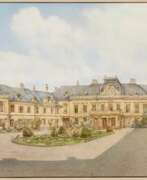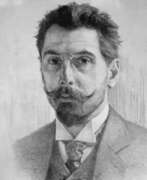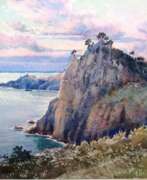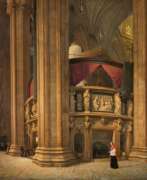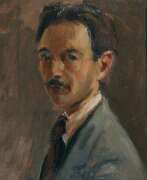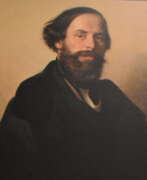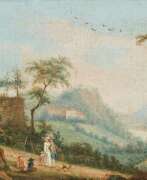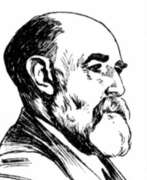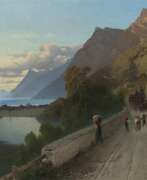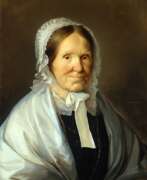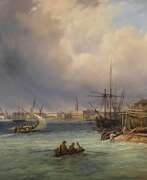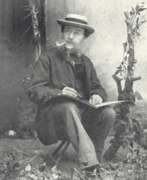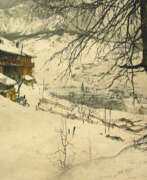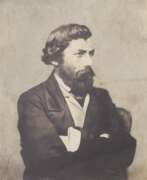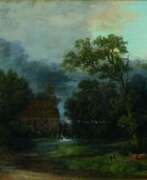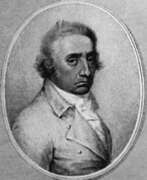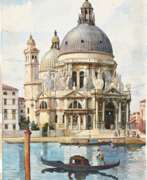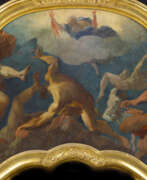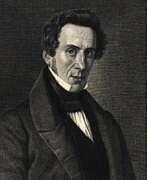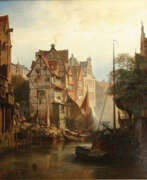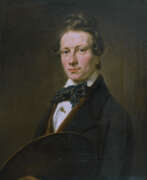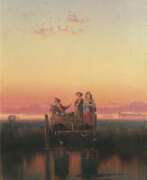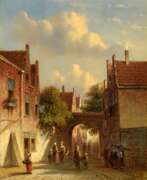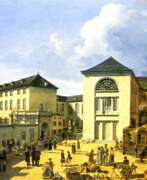Veduta 19th century


Leonardo Bazzaro was an Italian painter who worked mainly on landscapes and vedutas. He studied painting at the Brera Academy in Milan.
Leonardo Bazzaro is considered one of the leading representatives of Lombard naturalism.


Giuseppe Bernardino Bison was an Italian painter celebrated for his mastery in frescoes, landscapes, vedute, capriccios, and religious works. Bison's journey through art took him across Italy, leaving a legacy that bridged the 18th and 19th centuries. His education under the tutelage of Gerolamo Romani and Constantino Cedini at the Accademia of Venice laid the foundation for a career influenced by the luminaries of Venetian painting, such as Tiepolo and Francesco Guardi.
Bison's eclectic and versatile style made him a pivotal figure in prolonging the vedutist tradition. His oeuvre includes a significant number of graphic works alongside his frescoes and easel paintings, which often depicted topographical vedutas and fantasy scenes. He worked in various cities, including Ferrara, Trieste, and Padua, leaving behind numerous palaces and villas adorned with his frescoes.
His art found a market among the affluent non-aristocrats of the time, collaborating with art dealer Tosoni to produce landscapes and vedute that catered to local tastes. Despite his success in places like Trieste, Bison's later years in Milan were marked by smaller commissions and financial struggles.
Bison's works are preserved in esteemed collections worldwide, including the Cooper Hewitt, Princeton University Art Museum, University of Michigan Museum of Art, Clark Art Institute, Detroit Institute of Arts, and the Metropolitan Museum of Art, among others. His paintings, such as "The Arsenale in Venice," "The Hermits of Thebes," and "Capriccio of Padua," continue to captivate audiences with their intricate detail and historical value.
For collectors and experts in art and antiques, Bison's legacy offers a unique glimpse into the transition of Italian painting from the 18th to the 19th century. His ability to blend realism with fantastical elements makes his work a fascinating study in the evolution of European art.
For updates on exhibitions, sales, and auctions related to Giuseppe Bernardino Bison's works, sign up for our newsletter. Stay informed on the latest discoveries and opportunities to acquire pieces by this remarkable Italian artist.
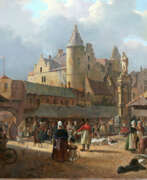

François-Antoine Bossuet was a painter and draughtsman of the Belgian school. Bossuet is known for his depictions of the landscapes, cities and monuments of Spain and Italy, with an emphasis on historic places, occasionally with genre scenes of everyday life. He is noted for the excellence of perspective in his paintings. He was professor at the Academy of Fine Arts in Brussels, from 1855 until 1876. His works may be seen in the Royal Museum of Fine Arts, Antwerp, the Royal Museums of Fine Arts of Belgium in Brussels, and the Victoria and Albert Museum in London.


Anton Burger was a German painter, draftsman and etcher. He was a prolific and versatile painter, producing works in almost every genre. His paintings sold very well and, in the area around Kronberg, it was considered a sign of good taste to have a "Burger" in one's home. In 1861, he and Jakob Fürchtegott Dielmann (an old friend from his days at the Städelschule) founded the Kronberg Artists' Colony, where he remained until his death. He was highly regarded and came to be known as the "King of Kronberg".


Giuseppe Canella, also referred to as Giuseppe Canella the Elder, was an Italian painter.
It may have been under the influence of Pietro Ronzoni, a landscape painter of international renown active in Verona, that he took up landscape painting.


Émile Pierre Joseph de Cauwer was a painter of architectural subjects. He was a pupil of his father, Joseph de Cauwer. He painted careful, detailed studies of buildings, amongst them the Church of St. Martin at Oudenarde, the Town Hall at Oudenarde, and the New Synagogue at Berlin.


Federico del Campo was a Peruvian painter who was active in Venice where he was one of the leading vedute painters of the 19th century. Demand for his views, particularly from English tourists was so strong that he painted several views multiple times.
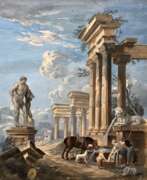

Pierre-Antoine Demachy was a French painter and master of architectural landscapes.
He studied architecture at the Royal Academy of Painting and Sculpture and specialized in drawing ruins, architectural structures and scenery. Due to his success in his art, he became a royal master of architectural decorations for entertaining events. Demachy also taught students of painting at the Louvre Palace.
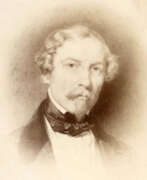

Eugène Flandin was a French artist and archaeologist. He is best known for his watercolor paintings of ancient monuments and landscapes in the Middle East, as well as his contributions to the field of Orientalist studies.
Flandin received his artistic training at the École des Beaux-Arts in Paris, where he studied under the painter Horace Vernet. He later went on to become a professor of archaeology and Oriental languages at the Collège de France.
Flandin's artistic work focused primarily on the ancient ruins and landscapes of the Middle East. Flandin was also a pioneer in the field of Orientalist studies, which focused on the art, culture, and history of the Middle East. He conducted extensive research on Persian and Ottoman art and architecture, and published several books on the subject.
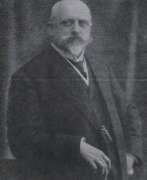

Theodor Groll was a German genre painter, landscape and architectural painter.
Theodor Groll was famous for his beautifully detailed architectural drawings. Besides Oswald Achenbach and Albert Flamm, he belongs to the "Italian painters" of the Düsseldorf School.
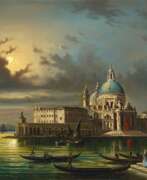

Giovanni Grubacs was a nineteenth-century Italian landscape painter.
The painter almost always exhibited paintings of Venetian landscapes, but while early in his career he strictly followed eighteenth-century prototypes, in later decades his style fell under the influence of Ippolito Caffi's deep naturalism, which gave life and expression to his works filled with more realistic figure groups, dramatic long views of the city bathed in iridescent atmosphere and illuminated by sudden flashes of light that create unique lighting effects.
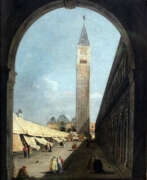

Giacomo Guardi was an Italian painter from Venice. The son of famous veduta painter Francesco Guardi, he continued his father's line of work, though without the same level of renown. The majority of his works are quite small views of only minor artistic interest, more akin to postcards than to his father's grand scenes, but he produced several paintings showcasing a notable level of artistic skill as well. Evaluating his legacy is somewhat complicated due to the frequency with which paintings are misattributed to him.


Johann Karl Hetz is a German painter and professor at the School of Applied Arts in Neuburg am Donau.
He studied at the Munich Academy of Fine Arts, and for more than 20 years was professor of drawing and modeling at the Royal School of Applied Arts in Munich.
Hetz painted many genre paintings, architectural sketches and landscapes of Bavaria, Swabia, Tyroli, Italy, Dalmatia, Bosnia and Herzegovina. He has exhibited a large number of watercolors from these southern countries in Bavarian exhibitions and galleries. Hetz is also a recognized master of interior paintings and genre scenes from the lives of ordinary people and the bourgeoisie in 19th century Europe. Many of his genre paintings were published as illustrations in newspapers and magazines. These works are a valuable source of information about the social trends of the time.


Louis-Gabriel Moreau was a French graphic artist and landscape painter.
He is frequently identified as "Moreau the elder" ("Moreau l’Aîné") in order to avoid confusion with his precocious younger brother, the artist Jean-Michel Moreau (1741–1814) who is sometimes identified as "Moreau the younger" ("Moreau le Jeune").


Johann Jakob Neustück was a Swiss artist, celebrated for his contributions to the art world during the 19th century. His work, primarily focusing on landscapes, captures the essence of Swiss scenery with remarkable detail and emotion.
Johann Jakob Neustück's art is a testament to his skill and passion, offering viewers a glimpse into the picturesque landscapes of Switzerland. His paintings are known for their precision and the ability to transport the observer to the scene depicted. One of his notable works, "View into the Cloister of the Cathedral of Basel," exemplifies his mastery in landscape painting, showcasing his attention to detail and the serene beauty of Swiss architecture and nature.
Collectors and art enthusiasts admire Johann Jakob Neustück's works for their historical value and artistic merit. His paintings not only serve as beautiful artifacts but also as cultural treasures that offer insights into Swiss history and landscape artistry.
For those interested in the world of art and antiques, especially in the realm of landscape painting, Johann Jakob Neustück's creations are a source of inspiration and admiration. His works, which have been auctioned and celebrated, continue to enchant and captivate audiences, affirming his legacy in the art world.
For collectors and experts in art and antiques, staying informed about Johann Jakob Neustück's works is essential. By signing up for updates, you will receive notifications about new product sales and auction events related to Neustück's art, ensuring you never miss an opportunity to explore or acquire pieces of his enduring legacy.


Edward Pritchett was a nineteenth-century English painter and man of mystery.
Little is known of Pritchett's life; he has appropriately been described as "elusive." Pritchett spent periods over three decades living and working in Venice, producing admirable views of the city; he was one of a group of English artists who produced notable records of the scenes of northern Italy, a group that included John Wharlton Bunney, James Holland, the brothers-in-law Luke Fildes and Henry Woods, and, in a later generation, William Logsdail.
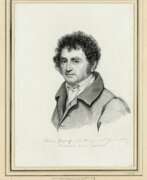

Johann Dominicus Quaglio was an Italian-born German painter of the first half of the 19th century. He is known as an architectural painter and graphic artist of the Romantic era, theater artist, lithographer and printmaker.
Quaglio traveled to various countries, which became a source of inspiration for his many works. He depicted medieval churches, castles, ruins and cities in his works. The master was one of the first to use lithography to recreate Gothic structures in graphic form. His works are historical and architectural documents of the time.
Quaglio was court painter to the Bavarian throne and a member of the Munich and Berlin Academies of Arts. He is considered by critics to have brought architectural painting back to a respectable level.
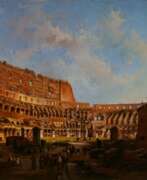

Luigi Querena was an Italian painter. Following in the footsteps of his father Lattanzio, a painter of historical and religious works, Luigi enrolled at the Venice Academy of Fine Arts at the age of 12 years. He studied under Federico Moja and distinguished himself as a vedute painter. The contemporary art critic Sagredo said that Luigi was reviving Canaletto.


Carl Gustav Rodde was a German painter.
Rodde studied at the Düsseldorf Academy of Fine Arts under Johann Wilhelm Schirmer and Hans Fredrik Gude, and painted landscapes around Weimar, Danzig, Düsseldorf and Berlin, as well as Italian landscapes and vedutas.
Carl Gustav Rodde specialized in picturesque landscapes embodying an idealized vision of rural life. He adored the countryside and often preferred to depict picturesque vistas under the rays of the setting sun.
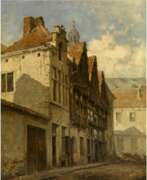

Hendrik Frans Schaefels or Henri François Schaefels, also known as Rik Schaefels was a Belgian Romantic painter, draughtsman and engraver known for his seascapes, cityscapes, genre paintings, landscapes with figures and history paintings. He worked in the Romantic style popular in Belgium in the mid nineteenth century and was highly esteemed in Europe for his representations of historic naval battles.


Aegidius Johann Peter Joseph Scheuren was a German painter and lithographer.
He painted portraits, landscapes, and veduta. His son Caspar Johann Nepomuk Scheuren became a famous landscape painter.


Bartholomeus Johannes van Hove was a Dutch painter and the father of Hubertus van Hove. He played an important role in the development of 19th-century painting by his many disciples. He was able to teach his skills to a large group of artists, of whom especially Johannes Bosboom and Jan Hendrik Weissenbruch would rise to great heights.
